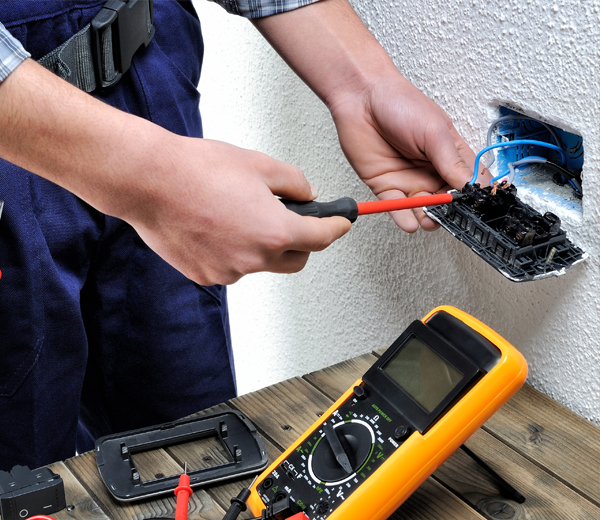PROGRAM
Electricity Technician

Diploma
Electricity Technician
Program Overview
The Electricity Technician Program at CBT Technology Institute prepares students for entry-level positions in the electrical industry, offering instruction in both English and Spanish from industry-experienced instructors. Supported by dedicated staff and faculty, and enriched by resources from valued industry partners, this student-focused program combines theory with hands-on training. As a student, you will learn the fundamentals of electricity, residential wiring per National Electrical Code guidelines, blueprint reading, and low voltage systems, including fire alarm systems.
Join us at CBT to gain the skills and receive the support you need to start your career as an Electricity Technician.
Program Details
- Credits: 24
- Program Length: 8 months
- Next Start Date: September 02, 2025
- Location: Offered in all 3 CBT campuses; Flagler, Hialeah, Cutler Bay
- Language of Instruction: English and Spanish
- Program Certifications: Fire Alarm Systems Agent, Burglar Alarm Systems Agent, OSHA 10, Industrial Controllers, Photovoltaic Energy Systems
Note: Completing a course or program in a language other than English may reduce employability where English is required.
COURSE DESCRIPTIONS
EET1000 – National Electrical Code (NEC) (3 Semester Credit Hours)
This course at our electrician school will help students to obtain a better understanding of the structure, regulations, principles and organization of the National Electrical Code (NEC). This course is also taught in the Spanish Language.
EET1033 – Fundamentals of Electricity (3 Semester Credits Hours)
This course offers a general introduction to the principles, concepts and laws applied to electric circuits. In-depth coverage of Ohm’s Law and its relation to voltage, current, resistance, followed by theoretical and practical applications of electrical components connected in series, parallel and series-parallel circuits. Also, the course focus on understanding of AC theory, components such as inductors, capacitors, transformers, electronics and semiconductors components, and its applications as well as the principles of operation of different devices and its appropriate selection.
EET1051 – Electrical Materials and Components (3 Semester Credit Hours)
This course will provide the students with adequate knowledge in order to identify the most common materials used in today’s industry as well as the proper understanding of related terminology. Topics covered in this course will permit future electricians to be familiar with current materials and components utilized for electrical projects at residential, commercial and industrial areas. A description of the diverse types of conductors used in lighting, entrant services, communications and control will be studied, together with explanations on boxes, tubing and fitting for circuit installations. Emphasis is focused on the service and distribution equipment, safety disconnection and fire protection, security, communication and digital control devices. This course is also taught in the Spanish Language.
CET1516 – Electric Motors Application (3 Semester Credits Hours)
This course is focused on the characteristics, operation, control, selection, installation and applications of different electric motors. Electric motors such as: single phase, three phases, hermetic compressors, multi-speed and variable and electronically commutated are studied. Activities in the labs are planned in order to connect, wiring starting methods, interpret connection diagrams and verify technical conditions of parts and troubleshooting. In addition, electrical and safety codes also will be emphasized.
EET1050 – Blueprint Reading (3 Semester Credit Hours)
This course will offer to future electricians efficient and accurate blueprint reading skills in the electrical area. Concepts of drawing, sketching, views, plans, schedules, and specifications are presented and then reinforced by current print reading practical exercises that will offer students proper practice in the interpretation and analysis of various prints in different electrical work areas. Students will benefit from experiencing electrical, mechanical, hydraulic, and specialized communication symbology that will improve their recognition and understanding of other craft symbols likely to be encountered on the job sites. Topics will also include applications and basic learning to sketch and electronic draft ladder diagrams, schematics, wiring diagrams, low and high voltage prints and others. This course is also taught in the Spanish Language.
BCT1630 – Residential Wiring (3 Semester Credits Hours)
This course will provide instruction in wiring methods for single family, two family, and multi-family residences. This course presents basic wiring techniques of electrical devices using schematics and wiring diagrams. In addition, future electricians will be trained to be familiar with electrical installation, operation, and maintenance of residential wiring. It will focus on general knowledge, safety, tools, blueprint reading, equipment, wiring, and the accepted wiring practices in accordance with the current edition of the National Electrical Code. This course is also taught in the Spanish Language.
FES1155 – Fire Alarm Systems (3 Semester Credits Hours)
The principal purpose of installing fire alarm systems is life safety, to know the code requirements and use this to design and install fire alarm systems assure this proposal being one of the principal goals in this course. With the aid of hand-on in the labs the students will get skills in the installation, commissioning and troubleshooting of systems of fire alarm.
EEV1230 – Low Voltage Security Systems (3 Semester Credit Hours)
This course is focused on requirements of design and installation of security systems including burglar alarm systems, CCTV systems and access control systems. The course provides specific information of applications and products which are employed in these systems, regulations and codes and cabling techniques.




